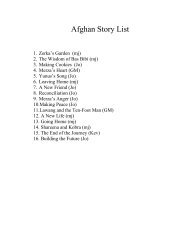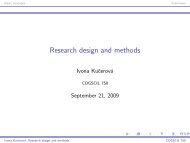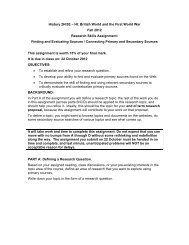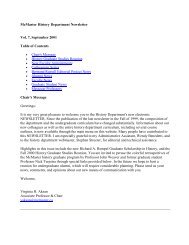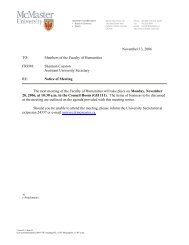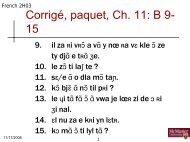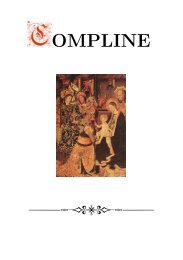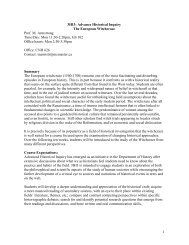McMaster Journal of Communication - McMaster University
McMaster Journal of Communication - McMaster University
McMaster Journal of Communication - McMaster University
You also want an ePaper? Increase the reach of your titles
YUMPU automatically turns print PDFs into web optimized ePapers that Google loves.
<strong>McMaster</strong> <strong>Journal</strong> <strong>of</strong> <strong>Communication</strong><br />
Fall 2004<br />
Volume 1, Issue 1<br />
ISSN 1710-257X<br />
The World <strong>of</strong> News:<br />
An International Comparative Analysis <strong>of</strong> Television News<br />
Imre Szeman, Anne Bain, Timothy Ho,<br />
Kurt Illerbrun, John Mani, Terri Rodak,<br />
Stephanie Witten, Bita Zakeri<br />
<strong>McMaster</strong> <strong>University</strong><br />
Keywords: television, news, globalization, national, international, social construction, framing,<br />
comparative<br />
Through an intensive, comparative study <strong>of</strong> daily news broadcasts from the United States,<br />
Canada, Great Britain, Israel, Iran, Japan, Hong Kong, and Hungary over a one-month period, the<br />
project will investigate the different ways in which major international events are covered in daily<br />
national news broadcasts. As highlighted by the recent disagreements over the role that the<br />
international community and the United Nations should play in world affairs, there are substantial<br />
differences around the globe concerning the character and significance <strong>of</strong> the challenges and threats<br />
facing humanity today. The television news provides one <strong>of</strong> the most important information<br />
sources worldwide for citizens and political leaders in the decisions and deliberations that they make<br />
on a daily basis. This is especially true with respect to national responses to international events and<br />
crises, which depend to a very large degree on information provided by major media sources on<br />
events taking place at distant locales. For this reason, the daily television news provides a rich site<br />
for the analysis <strong>of</strong> the social construction <strong>of</strong> the meaning and significance <strong>of</strong> contemporary political<br />
and social events, especially when such an analysis takes place in a comparative frame.<br />
In terms <strong>of</strong> a theoretical standpoint, we accept that news broadcasts inform viewer consciousness<br />
– how they perceive both the local and global world around them. A national citizenry obtains<br />
information about the world around them through the medium <strong>of</strong> television news. The<br />
institutionalized mediation <strong>of</strong> news to a national audience forms a viewership vis-à-vis the ritual <strong>of</strong><br />
the evening news. Therefore, it is important to study exactly what is conveyed through the news<br />
Research Note<br />
<strong>McMaster</strong> <strong>Journal</strong> <strong>of</strong> <strong>Communication</strong> ISSN 1710-257X Vol.1 pg1
and how it is presented – for it comes as close to representing the “truth” about the outside world as<br />
many people will ever know.<br />
The news is a construction. Events are presented as individual anomalous occurrences that are<br />
largely removed from a causal historical context. Events that take months or years to unfold receive<br />
little attention, whereas catastrophic events are given the headlines – <strong>of</strong>ten without accompanying<br />
background information. Despite the discontinuous nature <strong>of</strong> news sequences, broadcasts<br />
ultimately design a package to make the viewer feel informed. Additionally, it serves to reassure<br />
people and reinforce beliefs that a national community is meant to share. When comparing<br />
newscasts across cultures, then, it is significant to note the various ways in which differing social<br />
norms, cultural standards, and national ideologies are reinforced throughout a particular broadcast.<br />
The project will address three major questions:<br />
+RZGRHVWKHGDLO\QDWLRQDOQHZVLQGLIIHUHQWFRXQWULHVFRQVWUXFWWKHLQWHUQDWLRQDO·DQG<br />
relate local circumstances to global contexts?<br />
:KDWDre the differences in the events examined and highlighted, and the relative<br />
importance (or lack there<strong>of</strong>) assigned to them?<br />
:KDWNH\WHUPVRUFRQFHSWVDUHLPSRUWDQWLQFRQVWUXFWLQJWKHUHODWLRQVKLSRIQDWLRQDO<br />
contexts to international events, and how are these configured or expressed differently in<br />
different circumstances? (Examples might include concepts such as “globalization,”<br />
“democracy,” “freedom,” “free trade,” “autonomy,” “national sovereignty,” and “selfdetermination”)<br />
Research data will be collected via the Institute on Globalization and the Human Condition’s<br />
Global Video Facility at <strong>McMaster</strong> <strong>University</strong>, which allows for access to national daily news<br />
broadcasts through the SCOLA satellite service.<br />
While quantitative analysis is <strong>of</strong> limited utility for discursive analysis, it is necessary for<br />
comparative and classification purposes. Basic content analysis will determine how news broadcasts<br />
and stories are constructed and portrayed, how the news is delivered over a period <strong>of</strong> time, and who<br />
is given a voice throughout the broadcast. Delving deeper, discursive analysis will allow us to<br />
examine how the “national” and “international” are constructed by the broadcasts, what metaphors<br />
are employed, and how events, nations, and individuals are characterized.<br />
Our initial research allowed us to develop a protocol for data collection. The analysis will be<br />
conducted in two stages: individual broadcast analysis followed by a comparative analysis. Video<br />
content will be examined according to quantitative measures such as the number and length <strong>of</strong> news<br />
segments and qualitative discursive analysis, which will observe how news segments are framed,<br />
what rhetorical devices are used, and how conceptions <strong>of</strong> the ‘national’ or ‘international’ are<br />
developed. Details <strong>of</strong> the comparative analysis are in progress.<br />
We hope to present our findings at the 2004 Cultural Studies Association (US) Annual<br />
Conference in Boston, Massachusetts.<br />
Acknowledgements: This research project is made possible by a grant from the Petro Canada<br />
Young Innovator’ s Research Award.<br />
Research Note<br />
<strong>McMaster</strong> <strong>Journal</strong> <strong>of</strong> <strong>Communication</strong> ISSN 1710-257X Vol.1 pg2




